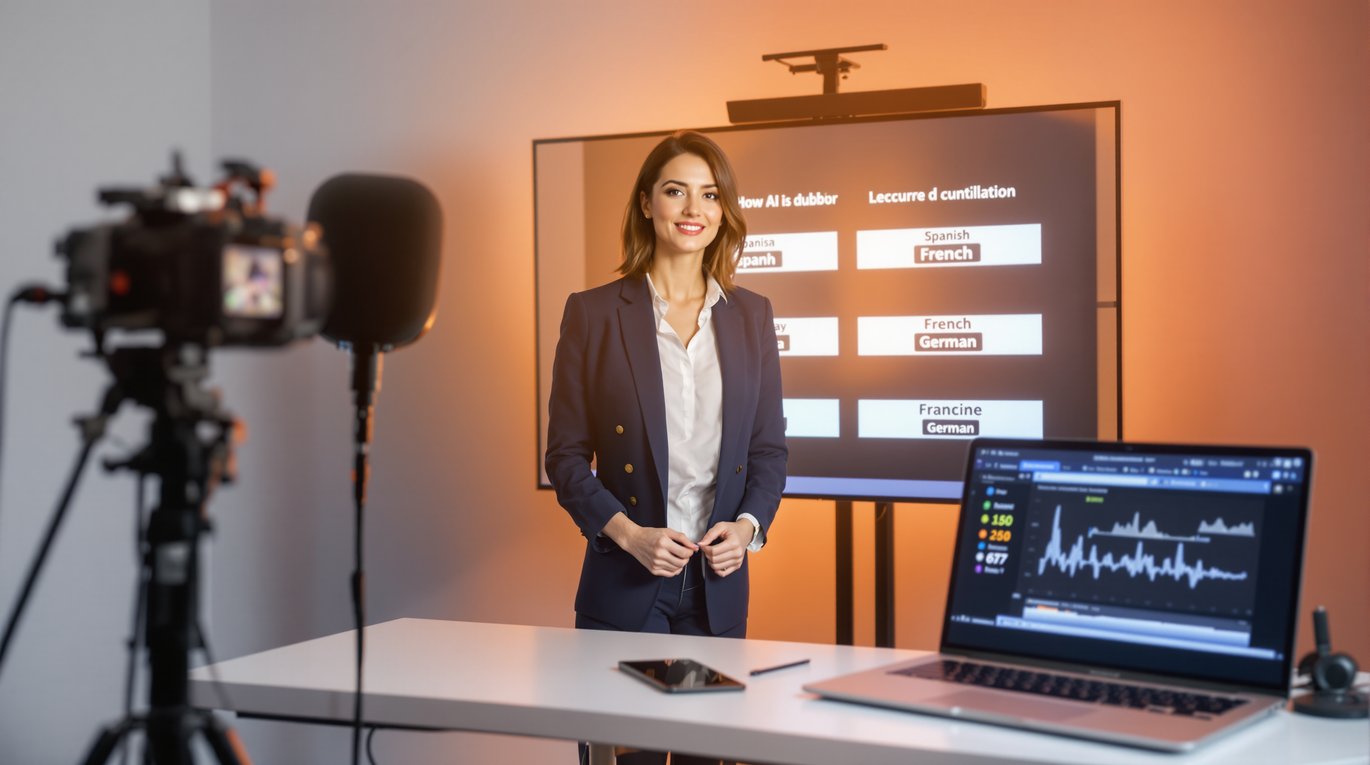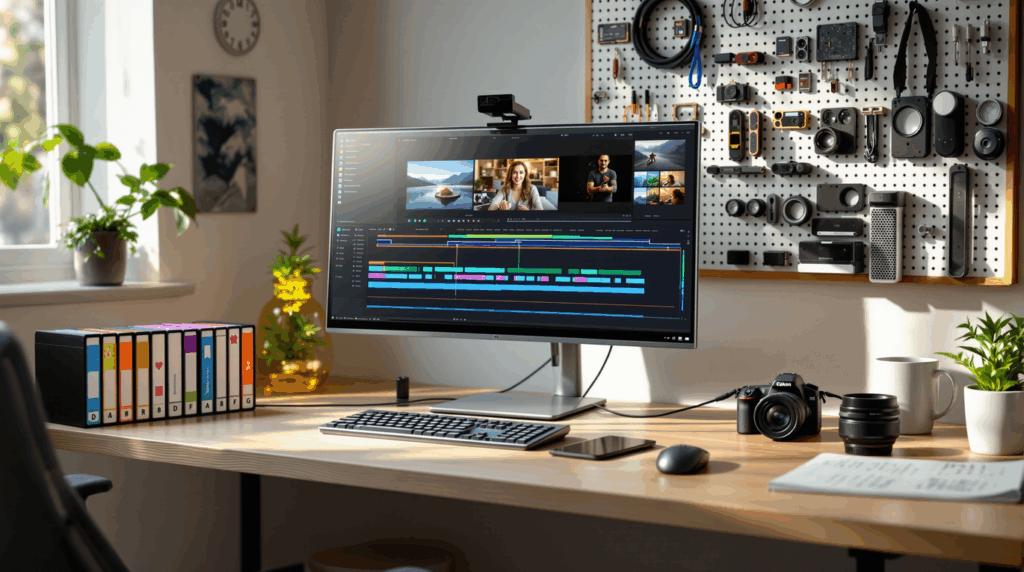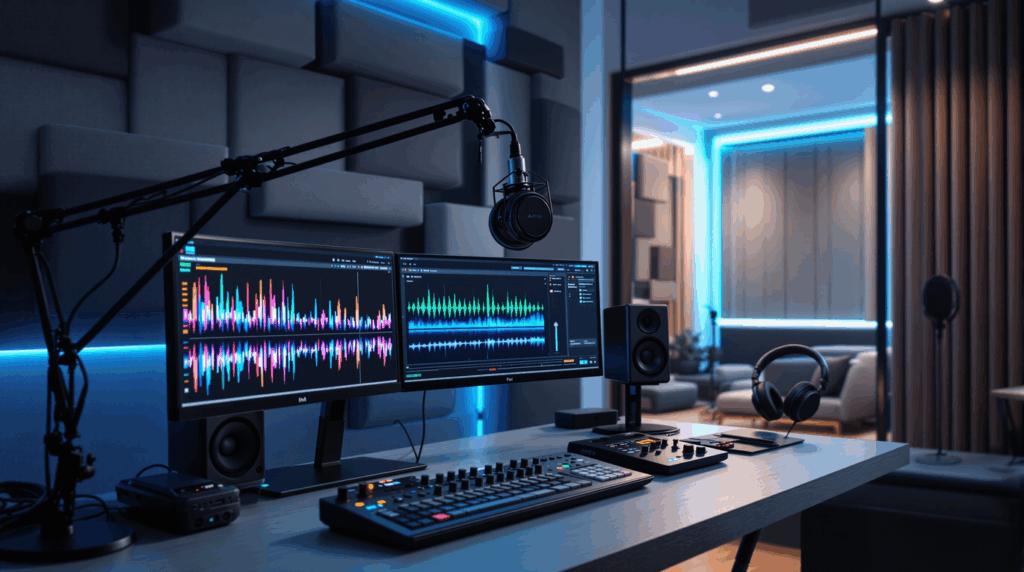AI video translation reshapes the scene in e-learning by cutting content development time from weeks to days. A real success story comes from an e-learning company that created 70 hours of content in German, French, Spanish, and Romanian in just two months.
The global film dubbing market will reach USD 5 billion by 2027, making AI dubbing online a breakthrough for course creators. Your educational content can now connect with international audiences faster. AI-powered solutions reduce traditional dubbing time from months to hours while keeping quality and emotional impact intact.
In this piece, you’ll learn to use AI video translation to work for your course content. We’ll cover everything from picking the right tools to creating an uninterrupted workflow.
Understanding AI Video Translation Technology
Modern AI video translation technology blends several sophisticated components to convert video content naturally between languages. The system processes visual and audio elements at the same time to match speech with lip movements perfectly.
How AI video translation works
Speech recognition technology starts the process by converting spoken dialog into text. Neural networks analyze the audio track to identify words, phrases, and speech patterns. The system then processes this text through advanced natural language processing algorithms that understand context and meaning.
The technology uses neural machine translation to convert the text into the target language. This translation looks at entire sentences and contextual relationships, not just individual words, to keep the language flow natural.
Key components of AI dubbing online
The essential components of AI dubbing systems include:
- Speech recognition and transcription engines
- Neural machine translation models
- Voice synthesis technology
- Lip synchronization algorithms
- Quality assurance systems
The voice synthesis component uses deep learning to create natural-sounding speech that matches the original speaker’s tone and emotion. On top of that, lip synchronization technology matches the dubbed audio with the speaker’s mouth movements to create a smooth viewing experience.
Latest advances in translation accuracy
Neural-network based approaches have improved translation quality by a lot. These systems now achieve unmatched translation accuracy and fluency. The technology handles complex language patterns and keeps consistency across different speakers in the same video.
Lip synchronization has made remarkable progress. Modern systems analyze and match lip movements with synthesized speech right away, which creates more natural-looking results. The sophisticated algorithms can predict and adjust speech timing to match visual cues perfectly.
Voice cloning capabilities have also improved. Current technology can copy a speaker’s unique voice characteristics in different languages while keeping emotional nuances and speaking style intact. Dubbed content maintains the original performance’s authenticity and impact this way.
Selecting the Right AI Translation Tools
Picking the right AI translation tool needs a good look at what each platform can and cannot do. Looking at these tools side by side shows how they stack up in accuracy, features, and pricing.
Top AI video translation platforms comparison
DeepL excels with its remarkable translation quality and higher accuracy rates for European languages. Google Translate supports over 100 languages, which makes it great for reaching global audiences. DeepL produces translations that sound more natural, especially with technical and specialized content.
OpenAI’s translation tools excel at getting context and nuances right, which makes them perfect for creative and marketing content. Both DeepL and OpenAI let you add glossaries and style guides to make your translations even better.
Essential features for course creators
Course creators need to pay attention to voice quality. The best AI video translation platforms deliver crystal-clear audio with natural-sounding voices instead of robotic output. The tools also come with features like voice cloning and emotional tone matching that keep content authentic across languages.
Data security matters a lot when you’re working with course content. DeepL’s secure processing protects your data, which makes it a good fit for educational institutions and corporate training materials.
Cost vs capability analysis
Each platform has its own way of charging users. DeepL asks for USD 25.00 per million characters after you use up your first 500,000 free characters. Google Translate comes in at a better price of USD 10.00 per million characters.
OpenAI does things differently by charging based on tokens instead of characters. You’ll pay about USD 1.50 to process 500,000 characters. The total cost of putting these tools to work depends on more than just the price per character:
- How well they work with your current systems
- Which language pairs you can use
- Features that help maintain quality
- What kind of technical support you get
Course creators who want the best results often find that spending more on sophisticated platforms pays off through better accuracy and natural translations. Your choice will depend on what you need, how much you can spend, and the quality you’re looking for.
Implementation Guide for Course Creators
The right preparation and structured approach make AI video translation successful. A well-laid-out workflow will give you the best results and help maintain educational quality in all languages.
Preparing your course content for translation
Your content needs full preparation before translation starts. Make sure all video scripts are final and avoid technical jargon. The data shows courses with clear, standard terminology achieve translation accuracy rates between 60-90%.
Create content that works across different regions. Remove references and idioms specific to one culture that might lose meaning in other languages.
The preparation phase needs systematic organization of course assets. Get all video files, scripts, and supporting materials ready in their final form. Studies show proper content preparation cuts translation errors by up to 40%.
Step-by-step translation workflow
A structured workflow helps you get consistent results across your course materials. Here’s everything you need to implement AI video translation:
- Content Analysis: Look at source materials and spot potential translation challenges
- Technical Setup: Set up translation tools and check compatibility
- Initial Translation: Run videos through your chosen AI dubbing online platform
- Voice Synchronization: Match dubbed audio with video timing
- Cultural Adaptation: Tailor content for target audiences
- Technical Integration: Add translated content to your learning platform
Quality assurance best practices
Quality assurance needs checks at multiple levels to verify translation accuracy and effectiveness. You should use both AI and human review to maintain high standards.
The best AI video translation happens when AI suggests and humans make final decisions. Research shows 87% of industry leaders prefer this approach.
Your testing protocol should check:
- Audio-visual sync technical verification
- Cultural appropriateness
- Language accuracy
- User experience
Set clear quality metrics and standards. Keep track of progress regularly. Data shows continuous quality checks can boost translation accuracy by up to 30%.
Success depends on attention to detail at every stage. A structured approach and high quality standards will help you create multilingual course content that strikes a chord with learners worldwide.
Optimizing Translations for Learning
AI video translation needs careful attention to cultural nuances and teaching clarity. Students are 94% more likely to participate when content matches their cultural context.
Cultural adaptation strategies
Good cultural adaptation goes beyond simple translation and needs a deep grasp of regional contexts. Local eLearning content with cultural adjustments shows 15% higher completion rates.
We focused on adapting examples that strike a chord with local audiences. The content has modified visual elements, adjusted teaching methods, and region-specific case studies. Course creators should make sure their content matches local educational norms and cultural values.
Maintaining instructional clarity
Clear instruction delivery stands at the forefront of AI video language translation. Quality assurance processes are vital. Students understand 20% more when courses have proper language quality checks.
Consistent terminology throughout course material strengthens learning objectives. This works especially when you have technical subjects, where precise language directly shapes understanding.
Handling technical terminology
Technical content needs special care during translation. A complete terminology management system is vital. Companies see 25% better translation accuracy when they make use of information from AI-assisted terminology management.
You can optimize technical translations by:
- Creating domain-specific glossaries
- Setting up terminology verification systems
- Keeping consistency across course modules
- Getting technical terms verified by subject matter experts
Translation Memory (TM) systems have shown excellent results. TM systems cut translation inconsistencies by 30% and ensure uniform technical terminology across different course modules.
Expert linguists balance technical accuracy and cultural fit. The combination of AI translation and human expertise creates 87% higher quality scores for technical content.
Overcoming Common Translation Challenges
Quality multilingual course content depends on how we handle translation challenges. AI systems don’t deal very well with certain accents, and error rates can reach up to 65% for specific regional dialects.
Managing accent and pronunciation issues
AI video translation systems have trouble with five major U.S. regional accents: Southern, New York City, New Jersey, Texan, and Boston. Limited training data and complex computational processing of diverse speech patterns cause these problems.
Advanced AI models use sophisticated algorithms to analyze speech patterns and facial movements. The research shows that adding diverse training data can boost accent recognition rates by up to 30%.
Dealing with idiomatic expressions
AI video language translation systems face unique challenges with idiomatic expressions. AI models don’t deal very well with context-dependent phrases and cultural references. This leads to literal translations that miss the intended meaning.
Modern AI dubbing online platforms use these tools to overcome these limitations:
- Advanced natural language processing
- Context-aware translation algorithms
- Cultural adaptation frameworks
- Machine learning models trained on idiomatic expressions
These solutions have boosted the accuracy of idiomatic translations by up to 40%. The best AI video translation systems combine AI capabilities with human oversight to ensure culturally appropriate translations.
Synchronization and timing fixes
Video translation faces another vital challenge in timing synchronization. Traditional dubbing methods can create major timing mismatches between audio and video. Advanced AI systems now tackle this issue with sophisticated lip-syncing algorithms and neural networks.
Google has made remarkable progress in this field. Their system uses a two-stage approach that isolates faces in normalized space, then uses conditional GAN-based methods to blend synthesized textures with the original video. This technique matches dubbed audio with visual lip movements with unprecedented accuracy.
Voice cloning technology has improved synchronization quality significantly. Modern AI systems can now copy a speaker’s unique voice characteristics while keeping emotional nuances across different languages. Dubbed content now maintains the authenticity of the original performance.
Some approaches use real-time adjustment capabilities to fine-tune audio-visual synchronization. These tools cut timing discrepancies by up to 50%. Machine learning algorithms help predict and adjust speech timing to match visual cues perfectly.
Course creators should prepare source materials properly to get the best results. Well-prepared content combined with advanced synchronization tools achieves lip-sync accuracy rates up to 90%. This means ensuring clear audio quality and proper video resolution to support accurate lip movement analysis.
Conclusion
AI video translation technology has shown its value to course creators who want to reach a global audience. Advanced neural networks and sophisticated algorithms have transformed what used to take months into a matter of days. Professional-quality translations now happen quickly in multiple languages.
Success depends on picking the right tools that match your needs. DeepL, Google Translate, and OpenAI come with their own strengths. Your choice should strike a balance between cost, capability, and quality needs. Efficient workflows and proper preparation lead to the best results. Content that adapts to cultural differences substantially increases student involvement.
Technical hurdles exist, particularly with accent recognition and timing synchronization. But modern AI systems now hit 90% accuracy in lip-sync matching. This makes dubbed content look and sound natural in different languages. Quality assurance practices help maintain educational value in every target language.
AI translation technology keeps getting better, making it easier to connect with international audiences. The key to successful course translation lies in both tech expertise and cultural awareness. These guidelines will help you create multilingual content that appeals to learners worldwide.
FAQs
Q1. How does AI video translation technology work? AI video translation combines speech recognition, natural language processing, and neural machine translation to convert video content across languages. It processes both audio and visual elements to ensure synchronization between speech and lip movements.
Q2. What are the key features to look for in AI translation tools for course creators? Essential features include high-quality voice output, customization options like voice cloning, emotional tone matching, data privacy measures, integration capabilities with existing systems, and comprehensive language pair support.
Q3. How can course creators prepare their content for AI translation? Course creators should finalize scripts, remove technical jargon and culture-specific references, and organize all course assets systematically. Proper preparation can significantly reduce translation errors and improve overall quality.
Q4. What strategies can be used to adapt course content for different cultures? Cultural adaptation involves modifying examples, adjusting teaching methodologies, and incorporating region-specific case studies. It’s crucial to ensure content reflects local educational norms and cultural values to increase student engagement.
Q5. How do AI translation systems handle accent and pronunciation challenges? Advanced AI models use sophisticated algorithms to analyze speech patterns and facial movements. By incorporating diverse training data, these systems can improve accent recognition rates. However, some regional accents still pose challenges, and combining AI capabilities with human oversight often yields the best results.



